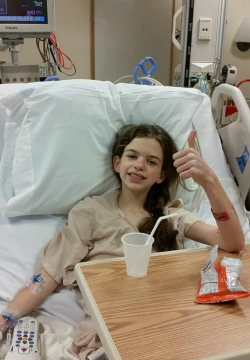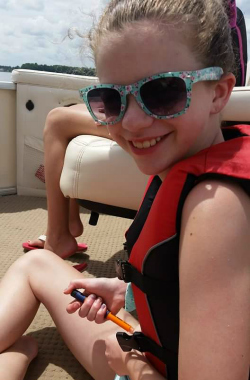
Lakin's Story

For the Bassler family, this past spring was filled with big changes and new learnings about type 1 diabetes. When 11-year-old Lakin started vomiting and losing weight inexplicably for two straight weeks, her local hospital referred her to Children’s National. Her blood sugar level was nearly seven times the normal level, so high that it didn’t even read on the glucose monitor. She was then transferred to Children’s Pediatric Intensive Care Unit (PICU) for treatment of diabetic ketoacidosis and to lower blood sugar, treating the acidosis and insulin deficiency for over 10 hours.
Afterwards, Lakin was transferred to the acute care unit where Fran Cogen, M.D., C.D.E., Director of the Childhood and Adolescent Diabetes Program, confirmed Lakin’s type 1 diagnosis and started the process for diabetes management. The Basslers then began a crash course in survival skills for diabetes, including type 1 diabetes education with Certified Diabetes Nurse Educator Cynthia Medford. “As an educator, my goal during teaching is to get the patients involved with the equipment, especially the home testing meter, by having them set up and touch the equipment,” said Cynthia.

Upon discharge from the hospital, Lakin was transferred to endocrinologist Priya Vaidyanathan, M.D., for her regular follow-up care. Lakin’s parents, Jennifer and Bruce, were impressed by how quickly Children’s was able to provide effective treatment and jump-start the education process.
“From the second we walked in the door, Children’s staff was waiting for her. Before you could even blink, everyone was working quickly and making sure she was comfortable,” said Jennifer. Children’s educators and physicians trained the family to administer insulin and showed them how to count Lakin’s carbs until they felt comfortable doing it on their own. “When they did their treatment team meetings, they included me,” said Jennifer. The Basslers never had to worry about being uncertain of the next steps in Lakin’s care routine.
 The diabetic educator explained clearly to Lakin what needed to be done to manage her diabetes. Lakin now counts her carbs, controls her portions, and eats certain foods in moderation. The Basslers even signed up for an advance carb counting class in August. Soon after treatment, Lakin was back in school and created a slideshow on diabetes to present to her class. “Lakin felt comfortable enough to demonstrate the skills she learned at Children’s, to her class upon returning to school,” said Cynthia. “I admire her efforts in taking on the responsibility of informing her classmates and teachers about diabetes management.”
The diabetic educator explained clearly to Lakin what needed to be done to manage her diabetes. Lakin now counts her carbs, controls her portions, and eats certain foods in moderation. The Basslers even signed up for an advance carb counting class in August. Soon after treatment, Lakin was back in school and created a slideshow on diabetes to present to her class. “Lakin felt comfortable enough to demonstrate the skills she learned at Children’s, to her class upon returning to school,” said Cynthia. “I admire her efforts in taking on the responsibility of informing her classmates and teachers about diabetes management.”
Lakin’s inspiration from the experience did not stop there. She recently won a $1000 scholarship at her school for an essay she wrote about chronic illness and diabetes. When she gets older, Lakin says, she also wants to help find the cure for incurable diseases. Jennifer’s advice to parents coming to Children’s with type 1 diabetes is to take it day by day, ask lots of questions, be patient, and don’t be afraid to call your physicians “It does get easier,” she said.
Our goal at Children’s National is to make it easier for patients and families, like the Basslers, to navigate diabetes and other illnesses to help kids grow up stronger and continue living healthy lives.




